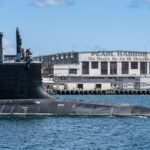
A top Navy official agreed with a Government Accountability Office (GAO) report that the service’s dearth of amphibious ships is decreasing its ability to train for many amphibious priorities.Vice Adm. Andrew Lewis, deputy chief of naval operations for Operations, Plans and Strategy (N3/N5), told a House Armed Services readiness subcommittee hearing Dec. 1, that due to the Budget Control Act (BCA) and repeated Continuing Resolutions (CRs) “the shortage of amphibious ships is the primary challenge to our Amphibious Training.”The GAO…

 By
By 











